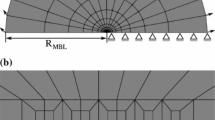Abstract
This paper is a continuation of two recent publications on crack growth in viscoelastic media. It provides further theoretical results for large strains that enable prediction of crack opening displacement for comparison with experimental data in the region of the singularity. In order to achieve good agreement with experiment it was necessary to account for far-field viscoelasticity. Additionally, it is found that with large deformation throughout the singularity, the deformation consists of simple shearing and stretching normal to the crack plane. Thus, there is no significant displacement parallel to the crack plane; such simplicity exists for materials that stiffen or soften at high strains if the stress obeys a power law in strain at high strains. This finding means that, despite the frame-dependence of the theory, there is no local rotation in the singularity to affect the stress.
















Similar content being viewed by others
Change history
31 May 2023
A Correction to this paper has been published: https://doi.org/10.1007/s10704-023-00706-x
References
Biot M (1965) Mechanics of incremental deformations. Wiley, New York
Ferry J (1980) Viscoelastic properties of polymers. Wiley, New York, p 1980
Fung Y (1965) Fundamentals of solid mechanics. Prentice-Hall, Englewood Cliffs, NJ
Ha K, Schapery R (1998) A three-dimensional viscoelastic constitutive model for particulate composites with growing damage and its experimental validation. Int J Solids Struct 35:3497–3517
Mai T, Okuno K, Tsunoda K, Urayama K (2021) Anisotropic stress-softening effect on fast dynamic cracks in filler-reinforced elastomers. Mech Mater 155:103786. https://doi.org/10.1016/j.mechmat
Morishita Y, Tsunoda K, Urayama K (2016) Velocity transition in the crack growth dynamics of filled elastomers: contributions of nonlinear viscoelasticity. Phys Rev E 93:043001
Mullins L (1969) Softening of rubber by deformation. Rubber Chem Technol 42:339–362
Schapery R (1975) A theory of crack initiation and growth in viscoelastic media, Part II: Approximate methods of analysis. Int J Fract 11:369–388
Schapery R (1982) Models for Damage Growth and Fracture in Nonlinear Viscoelastic Particulate Composites. Proc. Ninth U.S. National Congress of Applied Mechanics, ASME Book No. H0028, 237-245
Schapery R (1984) Correspondence principles and a generalized J integral for largedeformation and fracture analysis of viscoelastic media. Int J Fract 25:195–223
Schapery R (1999) Nonlinear viscoelastic and viscoplastic constitutive equations with growing damage. Int J Fract 97:33–66
Schapery R (2022a) A theory of viscoelastic crack growth-revisited. Int J Fract 233:1–16. https://doi.org/10.1007/s10704-021-00605-z
Schapery R (2022b) Stable and unstable viscoelastic crack growth: experimental validation of nonlinear theory for rubber. Int J Fract. https://doi.org/10.1007/s10704-022-00639-x
Schapery R, Park S (1999) Methods of interconversion between linear viscoelastic material functions. Part II approximate analytical method. Int J Solids Struct 36:1677–1699
Urayama K (2022). email communication.
Williams M (1957) On the stress distribution at the base of a stationary crack. J Appl Mech 24:109–114
Author information
Authors and Affiliations
Contributions
R.A. Schapery is the sole author.
Corresponding author
Ethics declarations
Competing interests
The authors declare no competing interests.
Additional information
Publisher's Note
Springer Nature remains neutral with regard to jurisdictional claims in published maps and institutional affiliations.
The original version of this article was corrected: values in Table 1 were corrected and section 5.8 was replaced with a new version.
Rights and permissions
Springer Nature or its licensor (e.g. a society or other partner) holds exclusive rights to this article under a publishing agreement with the author(s) or other rightsholder(s); author self-archiving of the accepted manuscript version of this article is solely governed by the terms of such publishing agreement and applicable law.
About this article
Cite this article
Schapery, R.A. Crack growth in viscoelastic media with large strains: further results and validation of nonlinear theory for rubber. Int J Fract 241, 121–139 (2023). https://doi.org/10.1007/s10704-023-00696-w
Received:
Accepted:
Published:
Issue Date:
DOI: https://doi.org/10.1007/s10704-023-00696-w




